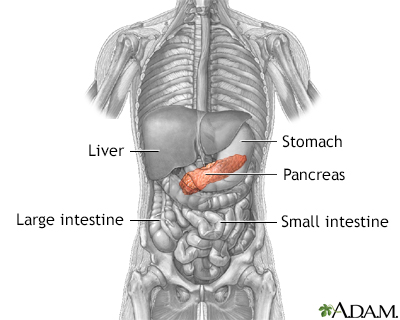Pancreatic abscess
A pancreatic abscess is an area filled with pus within the pancreas.
Causes
Pancreatic abscesses develop in people who have:
Abscesses
An abscess is a collection of pus in any part of the body. In most cases, the area around an abscess is swollen and inflamed.

-
Pancreatic pseudocysts
Pancreatic pseudocysts
A pancreatic pseudocyst is a fluid-filled sac in the abdomen that arises from the pancreas. It may also contain tissue from the pancreas, enzymes, a...
 ImageRead Article Now Book Mark Article
ImageRead Article Now Book Mark Article - Severe pancreatitis that becomes infected
Symptoms
Symptoms include:
-
Abdominal mass
Abdominal mass
An abdominal mass is swelling in one part of the belly area (abdomen).
 ImageRead Article Now Book Mark Article
ImageRead Article Now Book Mark Article -
Abdominal pain
Abdominal pain
Abdominal pain is pain that you feel anywhere between your chest and groin. This is often referred to as the stomach region or belly.
 ImageRead Article Now Book Mark Article
ImageRead Article Now Book Mark Article -
Chills
Chills
Chills refers to feeling cold after being in a cold environment. The word can also refer to an episode of shivering along with paleness and feeling ...
 ImageRead Article Now Book Mark Article
ImageRead Article Now Book Mark Article -
Fever
Fever
Fever is the temporary increase in the body's temperature in response to a disease or illness. A child has a fever when the temperature is at or abov...
 ImageRead Article Now Book Mark Article
ImageRead Article Now Book Mark Article - Inability to eat
-
Nausea and vomiting
Nausea and vomiting
Nausea is feeling an urge to vomit. It is often called "being sick to your stomach. "Vomiting or throwing-up forces the contents of the stomach up t...
 ImageRead Article Now Book Mark Article
ImageRead Article Now Book Mark Article
Exams and Tests
Most people with pancreatic abscesses have had pancreatitis. However, the complication often takes 7 or more days to develop.
Signs of an abscess can be seen on:
-
CT scan of the abdomen
CT scan
An abdominal CT scan is an imaging method. This test uses x-rays to create cross-sectional pictures of the belly area. CT stands for computed tomog...
 ImageRead Article Now Book Mark Article
ImageRead Article Now Book Mark Article -
MRI of the abdomen
MRI of the abdomen
An abdominal magnetic resonance imaging scan is an imaging test that uses powerful magnets and radio waves. The waves create pictures of the inside ...
 ImageRead Article Now Book Mark Article
ImageRead Article Now Book Mark Article -
Ultrasound of the abdomen
Ultrasound
Abdominal ultrasound is a type of imaging test. It is used to look at organs in the abdomen, including the liver, gallbladder, spleen, pancreas, and...
 ImageRead Article Now Book Mark Article
ImageRead Article Now Book Mark Article
Blood culture will show high white blood cell count.
Treatment
It may be possible to drain the abscess through the skin (percutaneous). Abscess drainage can be done through an endoscope using endoscopic ultrasound (EUS) in some cases. Surgery to drain the abscess and remove dead tissue is often needed.
Outlook (Prognosis)
How well a person does depends on how severe the infection is. The death rate from undrained pancreatic abscesses is very high.
Possible Complications
Complications may include:
- Multiple abscesses
-
Sepsis
Sepsis
Sepsis is an illness in which the body has a severe, inflammatory response to bacteria or other germs.
 ImageRead Article Now Book Mark Article
ImageRead Article Now Book Mark Article
When to Contact a Medical Professional
Contact your health care provider if you have:
- Abdominal pain with fever
- Other signs of a pancreatic abscess, especially if you have recently had a pancreatic pseudocyst or pancreatitis
Prevention
Draining a pancreatic pseudocyst may help prevent some cases of pancreatic abscess. However, in many cases, the disorder is not preventable.
Reviewed By
Michael M. Phillips, MD, Emeritus Professor of Medicine, The George Washington University School of Medicine, Washington, DC. Also reviewed by David Zieve, MD, MHA, Medical Director, Brenda Conaway, Editorial Director, and the A.D.A.M. Editorial team.
Barshak MB. Pancreatic infection. In: Bennett JE, Dolin R, Blaser MJ, eds. Mandell, Douglas, and Bennett's Principles and Practice of Infectious Diseases. 9th ed. Philadelphia, PA: Elsevier; 2020:chap 76.
Forsmark CE. Pancreatitis. In: Goldman L, Schafer AI, eds. Goldman-Cecil Medicine. 26th ed. Philadelphia, PA: Elsevier; 2020:chap 135.
Law R, Baron TH. Endoscopic treatment of pancreatic disease. In: Feldman M, Friedman LS, Brandt LJ, eds. Sleisenger and Fordtran's Gastrointestinal and Liver Disease: Pathophysiology/Diagnosis/Management. 11th ed. Philadelphia, PA: Elsevier; 2021:chap 61.
Van Buren G, Fisher WE. Acute and chronic pancreatitis. In: Kellerman RD, Rakel DP, eds. Conn's Current Therapy 2022. Philadelphia, PA: Elsevier; 2022:169-176.
Disclaimer




 All rights reserved.
All rights reserved.